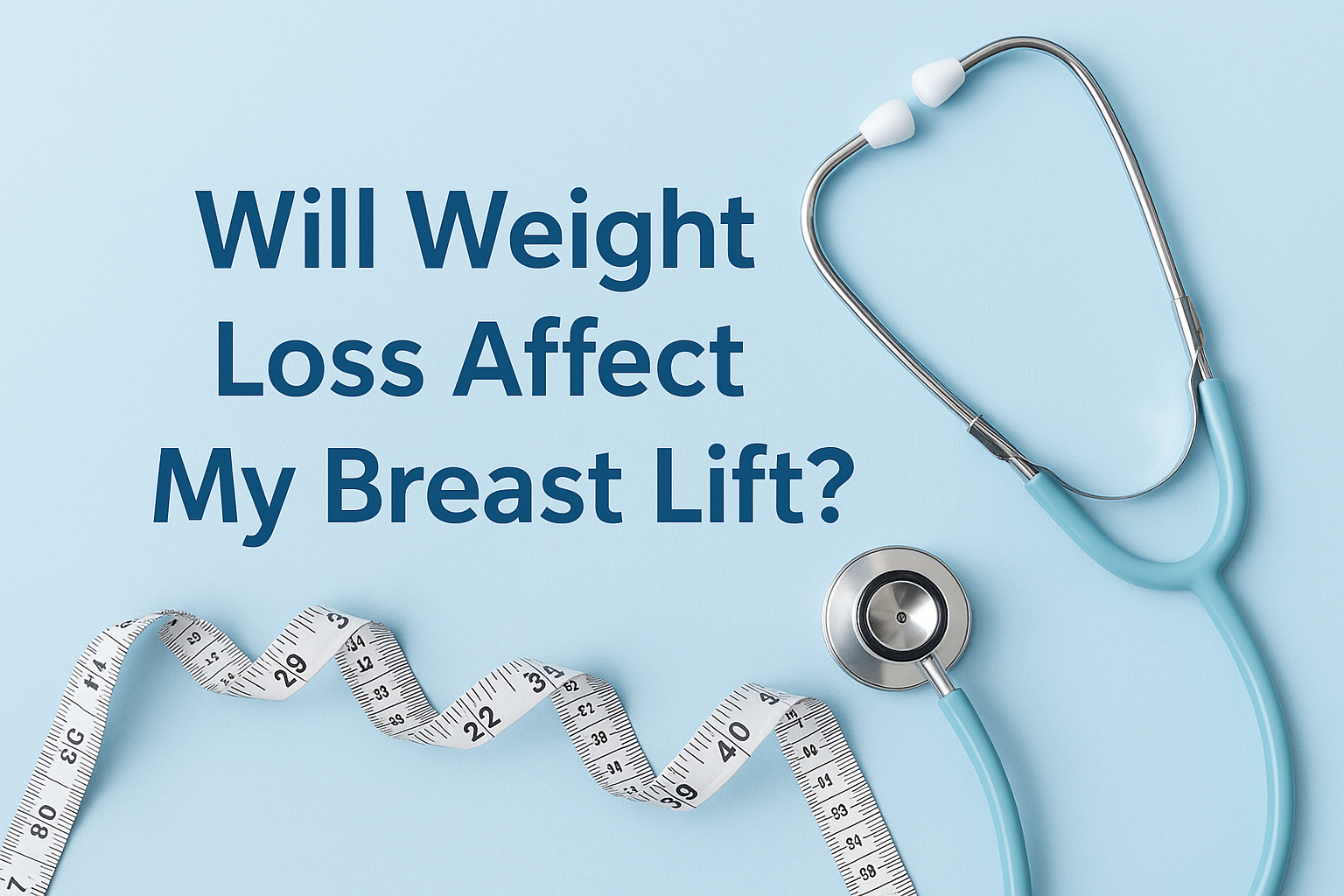Breast lift results are long-lasting when patients maintain a stable weight and adopt healthy habits. However, weight fluctuations, pregnancy, and aging may continue to affect breasts over time. By discussing concerns openly with a qualified plastic surgeon, patients can choose the right timing and approach for surgery. If these changes happen after your procedure, you may be at risk of affecting your breast lift.
What Happens If I Lose or Gain Weight After a Breast Lift?
A breast lift, also known as breast lift mastopexy, is a plastic surgery procedure designed to raise and reshape sagging breasts. Many patients undergo this surgery after pregnancy, weight fluctuations, or simply as part of the natural aging process. While the results can be long-lasting, the way your breasts look after surgery can be influenced by weight changes. Losing or gaining weight after breast lift surgery may alter the final appearance, sometimes in ways patients do not expect. Understanding how weight loss or gain affects breasts is essential when deciding when to pursue surgery and how to preserve your results.
How Weight Loss Can Affect Your Breast Lift Results
The Relationship Between Weight Loss and Breast Tissue
Breasts are composed of breast tissue, fat, and skin. When a patient loses weight, the amount of fat in the breast may decrease. For women whose breasts are made up of a higher percentage of fat, significant weight loss can lead to a noticeable reduction in breast size. This may affect breasts by making them appear smaller, less full, or less lifted, even after breast lift mastopexy.
The Role of Skin Elasticity
Skin elasticity plays a major role in how the breasts respond to weight changes. Younger patients or those with good skin elasticity may notice that their breasts maintain shape better after losing weight. Patients with less elasticity, or those who have already experienced sagging breast concerns, may develop sagging skin again after losing weight. In cases of significant weight loss, excess skin may develop, impacting breast lift results.
The Impact of Weight Loss on Surgical Results
Even though breast lift surgery removes and tightens excess skin, future weight fluctuations can still stretch the tissue. Patients who undergo breast lift after weight loss are often pleased with the results, but if additional weight is lost later, breasts may lose volume and appear less perky. In some cases, patients may consider additional plastic surgery such as breast augmentation or breast reduction to refine the final appearance.
Why Maintaining a Stable Weight Is Key After a Breast Lift
One of the best ways to preserve breast lift results is to maintain a stable weight. When a patient loses weight or gains weight repeatedly, this cycle places stress on breast tissue and skin. Over time, this may undo the improvements of breast lift surgery. For this reason, surgeons often recommend reaching and maintaining a goal weight before undergoing plastic surgery. By doing so, patients reduce the risk of sagging breast concerns returning due to weight fluctuations.
Stable weight management not only helps protect the shape and size of the breasts, but it also ensures that the results of surgery are longer lasting. Patients who are committed to maintaining a healthy lifestyle typically report higher satisfaction with their breast lift mastopexy results.
How to Preserve the Results of Your Breast Lift
Protecting the outcome of breast lift surgery requires ongoing effort. Patients can take several steps to maintain a youthful, lifted appearance:
- Maintain a stable weight: Avoid large fluctuations in body weight to prevent stretching of the breast skin.
- Adopt healthy eating habits: Balanced nutrition helps regulate weight and supports healthy skin.
- Exercise regularly: Strength training and cardiovascular exercise help keep overall body composition consistent.
- Wear proper support: Quality bras reduce strain on breast tissue and help maintain surgical results.
- Protect your skin: Using sunscreen and moisturizers helps preserve skin elasticity.
By combining these habits, patients can extend the life of their breast lift results and minimize the risk of sagging skin reappearing.
Frequently Asked Questions About Weight Loss and Breast Lifts
How Much Weight Can I Safely Lose After a Breast Lift?
Most surgeons recommend that patients avoid significant weight loss after surgery, since it can affect breasts by reducing volume. Small amounts of weight loss, such as 5 to 10 pounds, typically do not dramatically alter breast lift results. However, losing 20 pounds or more after surgery may change breast size and shape.
How Much Weight Should I Lose Before Having a Breast Lift?
Ideally, patients should reach their goal weight before undergoing breast lift mastopexy. Being close to your goal weight reduces the risk of additional sagging skin after surgery. Significant weight loss after surgery can compromise the outcome, so reaching a healthy, stable weight is best.
Can I Get a Breast Lift if I’m Overweight?
Yes, overweight patients can undergo breast lift surgery. However, excess weight can affect breasts and overall healing. Many plastic surgeons recommend achieving a healthy weight range to minimize surgical risks and achieve more predictable results. For some women, combining breast lift with breast reduction may provide better results if there is a large amount of breast tissue or sagging breast skin.
Can I Get a Boob Job While I’m Still Losing Weight?
Patients should avoid breast augmentation or breast lift mastopexy until weight loss has stabilized. If you undergo surgery while still losing weight, breast tissue and skin may continue to change, leading to less predictable results. It is best to maintain a stable weight for several months before considering plastic surgery.
Do Breasts Look Bigger or Smaller When You Lose Weight?
This depends on how much breast tissue is composed of fat. For many women, breasts become smaller after weight loss. In some cases, breasts also appear saggy due to excess skin. Others may notice their breasts appear slightly lifted if only a small amount of weight is lost. Every patient’s body responds differently, but significant weight loss often results in smaller, less full breasts.
Scheduling a Consultation
If you are thinking about breast lift surgery, or if you are concerned about how losing weight may affect breasts after surgery, scheduling a consultation with a board-certified plastic surgeon is the most important step. A surgeon can evaluate your breast tissue, discuss your goals, and provide a personalized plan.
Patients considering a breast lift after weight loss should be mindful of their goal weight and the amount of weight they may still want to lose. Significant weight loss after breast lift mastopexy can lead to sagging breast tissue or excess skin, which may alter the final outcome. For this reason, plastic surgeons often recommend that patients maintain a stable weight before scheduling breast lift surgery.
If you are currently losing weight, a consultation can help determine whether to wait until you reach your goal weight. Patients who undergo surgery too soon may risk additional sagging skin or unsatisfactory breast lift results. On the other hand, those who have already achieved weight stability are often excellent candidates for plastic surgery.
It is also possible to combine breast lift mastopexy with other procedures. Breast augmentation can restore fullness if breast size has decreased due to weight fluctuations. For patients with a large amount of breast tissue, breast reduction may be considered to create a more proportional shape.
If you are ready to learn more about how breast lift surgery can restore a youthful contour, schedule a consultation with a surgeon experienced in breast lift mastopexy and post-weight-loss procedures. An individualized plan will help you achieve long-term results while addressing sagging skin, excess breast tissue, and the impact of weight fluctuations.

